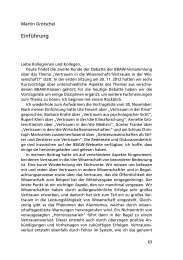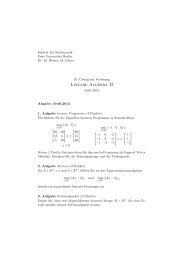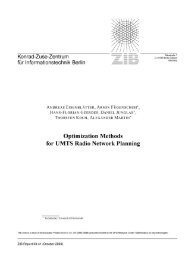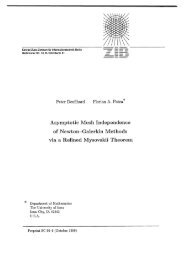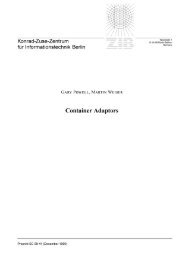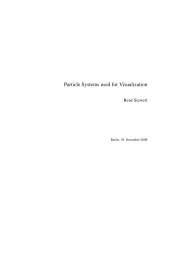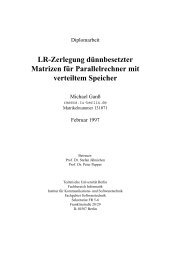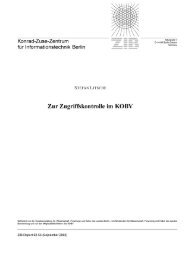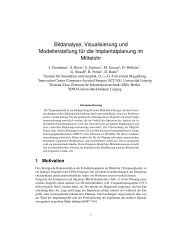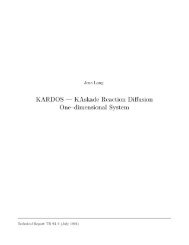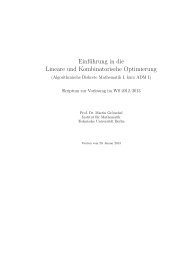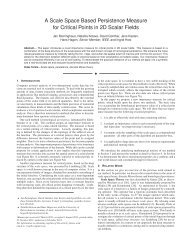Implementation of Cutting Plane Separators for Mixed Integer ... - ZIB
Implementation of Cutting Plane Separators for Mixed Integer ... - ZIB
Implementation of Cutting Plane Separators for Mixed Integer ... - ZIB
You also want an ePaper? Increase the reach of your titles
YUMPU automatically turns print PDFs into web optimized ePapers that Google loves.
2.3 Computational Study 13<br />
separators. Thus, evaluating the per<strong>for</strong>mance <strong>of</strong> each separator <strong>for</strong> all possible combinations<br />
<strong>of</strong> these choices is practically impossible. Inspired by the work <strong>of</strong> Gu,<br />
Nemhauser and Savelsbergh [30], we use <strong>for</strong> each separator the following approach<br />
in our computational study. We give a default algorithm, which represents a set <strong>of</strong><br />
choices which are basic, i.e., the set does not contain choices which are modifications<br />
<strong>of</strong> algorithmic aspects that may lead to an improved per<strong>for</strong>mance. Then, we present<br />
computational results which compare the per<strong>for</strong>mance <strong>of</strong> the default algorithm to<br />
the per<strong>for</strong>mance <strong>of</strong> an algorithm in which a single choice has been altered. We only<br />
modify this approach if not using a basic choice <strong>for</strong> an algorithmic aspect leads to<br />
such a small number <strong>of</strong> cuts found by the default algorithm that the results <strong>for</strong><br />
altering other single choices would not be very meaningful.<br />
The results will be presented in the following way. In the tables containing the results<br />
<strong>for</strong> the default algorithms (Table B.3, B.22, B.28, B.36, and B.48), we state the<br />
per<strong>for</strong>mance measures Gap closed %, Cuts, Sepa Time and Sepa Time Average (there<br />
will be three default algorithms <strong>for</strong> the cutting plane separator <strong>for</strong> the 0-1 knapsack<br />
problem, because we consider three classes <strong>of</strong> valid inequalities). At the bottom <strong>of</strong><br />
the tables, in the row labelled Total, we give the sum <strong>of</strong> the values <strong>of</strong> each per<strong>for</strong>mance<br />
measure over all instances, and in the row labelled Geom. Mean, we give the<br />
geometric mean <strong>of</strong> the values <strong>of</strong> each per<strong>for</strong>mance measure over all instances where<br />
individual values smaller than one were replaced by one. In the tables containing<br />
the results <strong>for</strong> altering a single choice <strong>for</strong> each cutting plane separator (see e.g. Table<br />
B.4), we report in addition <strong>for</strong> each per<strong>for</strong>mance measure the difference to the<br />
corresponding default algorithm. Here numbers in blue color indicate that the value<br />
<strong>of</strong> the per<strong>for</strong>mance measure obtained by the altered algorithm is better than the<br />
one obtained by the default algorithm, and numbers in red color indicate that the<br />
value <strong>of</strong> the per<strong>for</strong>mance measure obtained by the altered algorithm is worse than<br />
the one obtained by the default algorithm. Note that <strong>for</strong> Gap closed % the △ value<br />
<strong>for</strong> each instance, <strong>for</strong> Total and <strong>for</strong> Geom. Mean is given in percentage points, not<br />
in percentage.



